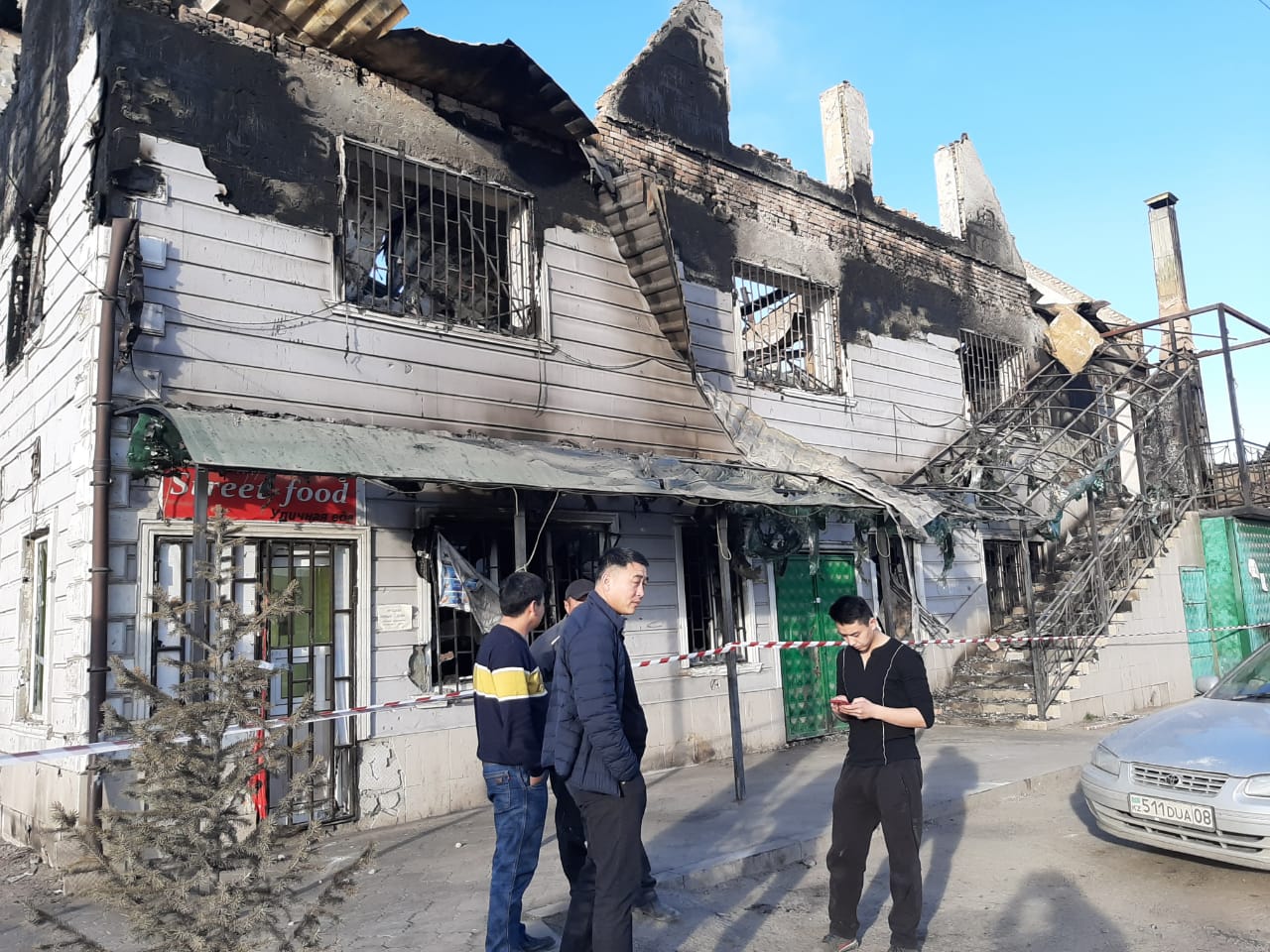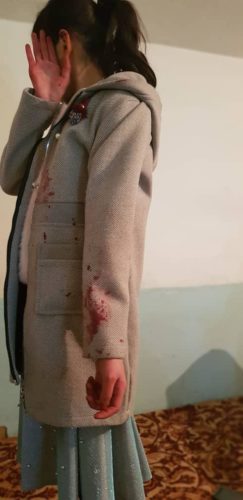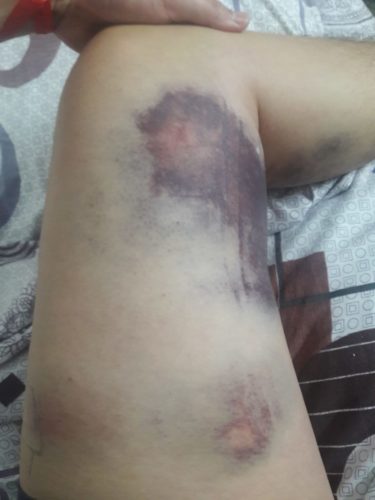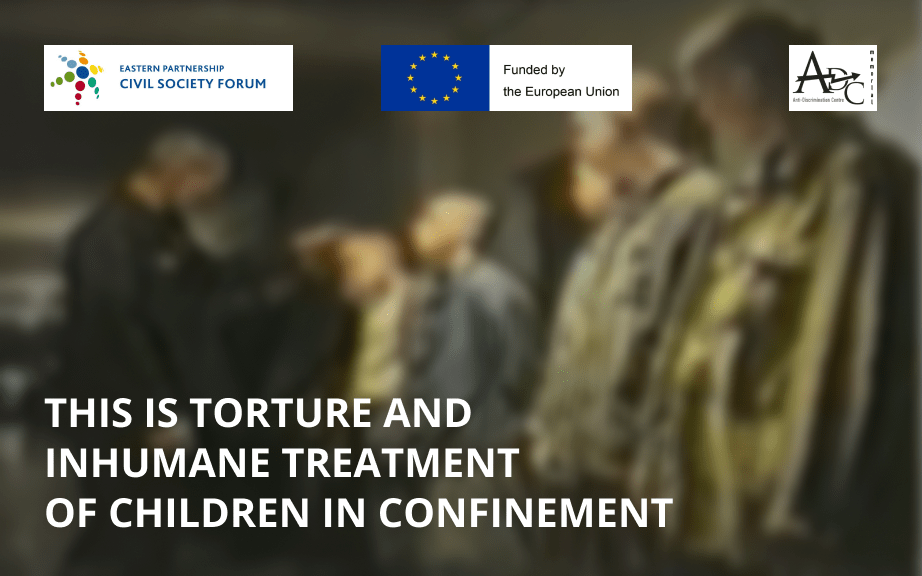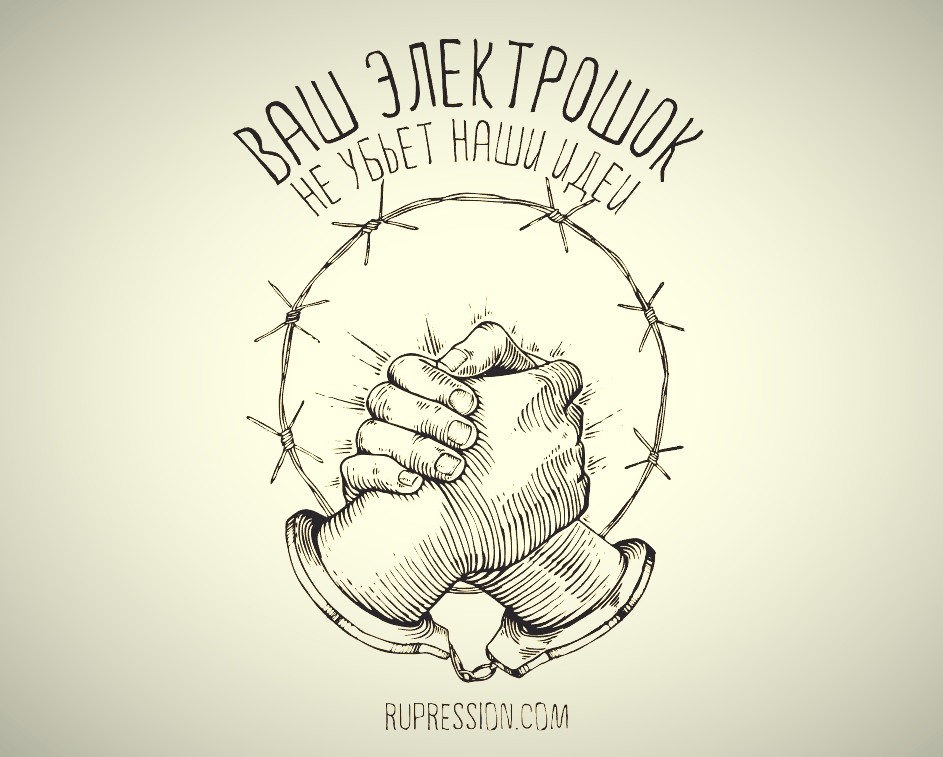On February 7, 2020, the most extensive ethnic conflict seen in Kazakhstan in recent years occurred when hundreds of pogromists attacked the Dungan villages of Masanchi, Sortobe, Bular Batyr, and Aukhatty. Against the backdrop of the Kazakh people’s customary belief that their country is a “paradise where different peoples live together in peace and friendship,” which was cultivated under Nazarbayev, the news of the tragedy in Korday District disrupted social networking sites and became the most discussed topic in the media. The reaction of the Kazakh government was much less marked, while the international community said almost nothing (international organizations and independent experts were not allowed to enter the conflict zone).
It appears that even official statistics speak eloquently about which side suffered in the conflict: 10 Dungans and one Kazakh died, and damages to property owned by Dungans (homes, commercial structures, retail sites, vehicles) amounted to millions of dollars. A long-term and grave consequence of this pogrom is intense psychological stress for the children and adults living in these villages and a loss of a sense of security and trust in their neighbors. The Kazakh government, however, continues to deny the conflict’s ethnic subtext, instead calling it mass unrest, and refuses to recognize the Dungan people as the victims. The same thing is happening with public opinion: People continue to make speeches about how the Dungans are “guests” who took advantage of the goodwill of their Kazakh “masters” who “offered them refuge in their land.”
One-sided investigation and prosecution of Dungans from the affected villages
The authorities of Kazakhstan reported that 120 criminal cases were initiated due to pogroms in Korday district. 1InformBuro, The suspects in murders and arsons in Korday district are not identified, https://informburo.kz/novosti/zamgenprokurora–po–faktam–ubiystv–i–podzhogov–v–kordayskom–rayone–podozrevaemye–vsyo–eshchyo–ne–ustanovleny-103195.html [in Russian]. On March 27, 2020, Deputy Prosecutor General Erlik Kenebayev stated that 25 persons who had taken active part in the mass riots had been detained. According to him, Kazakh, Dungan, and Kyrgyz people were detained 2Tengrinews, Special operation because of riots in Korday was conducted in Almaty, Shymkent and Zhambyl region, https://tengrinews.kz/kazakhstan_news/spetsoperatsiyu-iz-za-besporyadkov-kordae-proveli-almatyi-396314/ [in Russian].On April 14, 2020, the Almaty City Court held 24 people for two months—until the end of May—under suspicion of participating in the mass unrest. The life and health of the detainees is under threat: On April 29, 2020, the press office of the Prosecutor General of Kazakhstan reported that at 8 a.m. Bekbol Kibaev, one of the people accused in the mass riots, was found by his cellmates in the sanitary unit of the detention facility bleeding from wounds to his upper arm 3Tag News, Arrested on the case of pogroms in the Korday district died in the detention facility in Almaty, https://kaztag.kz/ru/news/arestovannyy–po–delu–o–pogromakh–v–kordayskom–rayone–umer–v–sledstvennom–izolyatore–v–almaty [in Russian]. Doctors did not manage to save him, and he died from blood loss.
The investigation is not transparent and appears to be one-sided. Forty-seven people were detained immediately following the pogrom. Three Dungan people were arrested, and 44 Kazakh people were released. As of May 13, 17 of the 25 people arrested or convicted were Dungan. Of these 17, five were already convicted as participants in conflicts that preceded the pogroms. On April 24, 2020 the Korday District Court handed down sentences to two Dungans—a father and son, who had a conflict with a Kazakh family in the village of Sortobe on February 5 (this conflict had no connection with the pogroms, but it was later presented as a cause of the pogroms). Even though the conflict was resolved by the families (the Kazakh family accepted an apology and financial compensation from the Dungan family), the court found the Dungans guilty of hooliganism and infliction of injuries. The father, Ersman Yunhu, was sentenced to 2.5 years restriction of liberty and six months of community service. His son, Marat Yunhu, was sentenced to two years’ imprisonment. Both were fined huge sums. The defense believes that the sentence was unjust and based on false information. Three participants from the traffic police were also convicted and sentenced to 1.5 years in prison.
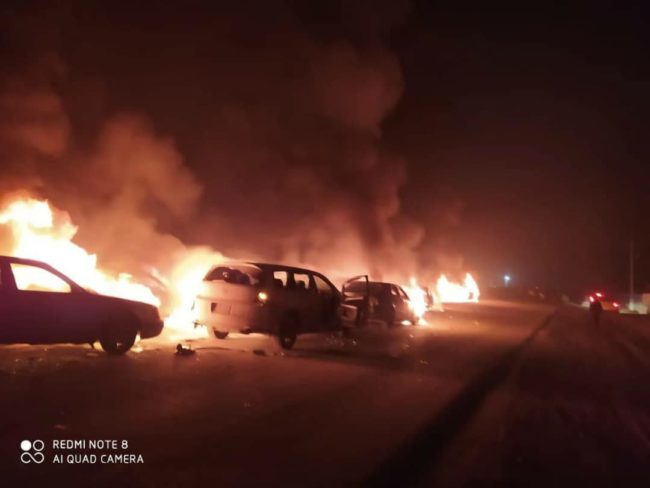
It is still not known if the perpetrators of the murders, injuries, destruction of property, and pillaging have been identified and detained. But it is crystal clear that Dungans are being persecuted: They are providing information about unending violations of their rights, illegal searches, and torture of arrested people in police precincts during interrogations lasting hours (beatings, placement of plastic bags over people’s heads, intimidation). These people are being charged with throwing rocks in an attempt to stop the pogromists and attempts have been made to force them to confess to the serious crime of killing an ethnic Kazakh who actively participated in the pogrom and died (witnesses assert that he killed two Dungans with his car and then drove into gas station). ADC Memorial has in its possession statements submitted to offices of the prosecutor that set forth the circumstances of the police’s illegal actions in late April 2020 and photographs of the victims with evidence of beating and torture. This information was shared with human rights defenders working in Kazakhstan to combat torture and also appeared in the media.
A detailed chronology of arrests, searches, and interrogations conducted in gross violation of the law is contained in an appeal made by the Dungan community to international organizations on May 20, 2020. It describes intimidation and psychological pressure, searches and arrests during nighttime hours, the participation of soldiers from special units who covered their faces in masks, interrogations lasting for hours, and beatings. The appeal also states that police officers did not always show official documents sanctioning searches and arrests and offended and threatened members of Dungan families and describes cases where relatives of detainees died due to stress. Because of the situation with COVID-19 and the related restrictive measures, the detainees have virtually no access to qualified legal assistance due to restrictions on movement. Lawyers from Korday represent all the detainees because it has not been possible to hire lawyers from Almaty or other regions.
Dungans started to be arrested again in late April. In one case, A. Masanov was arrested in his home early in the morning without being shown any documents. He was handcuffed and taken to the local precinct, where five police officers started to beat him in an attempt to make him confess to murder and threatened him with a 20-year sentence if he refused to confess. He was beaten and tortured all day and taken out of the precinct every three hours. He was released at 10 p.m., with the threat that his situation would be worse if anyone heard about the beatings and torture. Even senior citizens are subject to arrest. In late April, an elderly woman, Tsunder Khusezova, died during a search (her son was taken in for an extended interrogation and returned at night with signs of a beating). In another case, D. Seyshnalo (Bular Batyr) started to feel sick during a search of her home and fainted.
In late April, the Dungans who suffered during their arrests and searches appealed to offices of the prosecutor general, but with little result: On May 5, three months after the tragedy, 25 residents of Bular Batyr and Sortobe were brought to Korday for a forensic medical exam, and on the night of May 6, 2020, the home of Lugmar Lokhash, who died as a result of the unrest, was searched. Following this search, three of Lugmar’s brothers (Ramazan, Nabi, and Ledzher), who did not participate in the events of February 7 and 8, 2020, were arrested. They were tortured in an attempt to make them admit to a murder that took place during the pogroms.
On May 12, Sortobe residents I.A. Kimurov, I.Sh. Khizhin, and M.Shch. Khizhin were placed under arrest for two months in connection with charges under Article 272 of Kazakhstan’s Criminal Code (participation in mass unrest). According to their relatives, they were charged with murder of a pogromist after allegedly confessing. On May 13, searches were conducted at the homes of A. Mashanlo, B. Daurov, I. Cheshanlo in gross violation of the rules, and they were interrogated at the police precinct in Korday. A. Mashanlo was released on his own recognizance and the other two were arrested. Shch. G. Sangui, born 1965, was arrested on May 14.
The government has denied any ethnic component to the conflict in its responses. While publications provoking ethnic hatred and providing false information about the situation in Korday District were disseminated by some public figures and politicians in February 2020, these politicians have not been held liable for this.
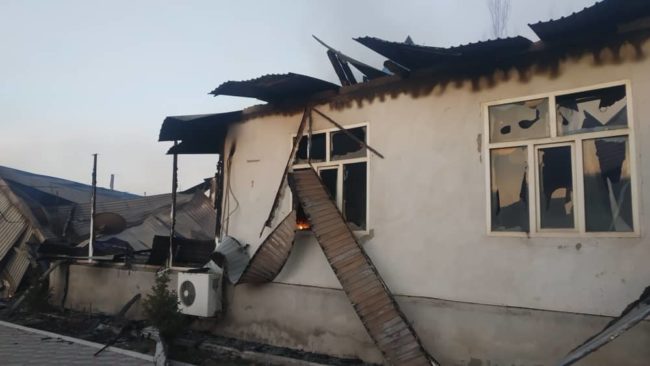
The victims of the pogroms have yet to receive any compensation or assistance from the government. Many families lost all their properties, businesses, vehicles, and equipment; they are in a difficult financial situation and rely on assistance from their relatives. Below is a Dungan activist’s appeal to international organizations:
“In terms of the question of compensation for material damages caused by the conflict, as of today, three months after the conflict, not one person, not one family, not one business has received anything. On top of that, the state refused to fulfill its obligations to compensate for damages. A private charitable fund called Shchivon was created by private individuals of the Dungan and Kazakh ethnicities. According to its bylaws, it is supposed to attract private donations and distribute these funds to the victims in accordance with estimates approved by the state committee assigned with calculating the losses associated with the events of February 7 and 8, 2020. The fund’s activities are managed from outside by district and regional leaders, who are the nominal directors of the fund. They do not have any powers, but they do bear full responsibility for the business part. The process for determining the amount of damages was a mere formality. No consultations were held with the population, and the losses incurred by businesses were not calculated. Members of the committee represented by local government bodies brought agreements for assistance to business owners and demanded that they sign them. Many refused to sign because they did not agree with the amount of compensation, which, in turn, led to threats and pressure from local government and law enforcement bodies. Any attempt by the community to instill the process with transparency was ignored or met with threats and persecution.”
How the pogrom occurred
The tragic events of February 7 were preceded by two unrelated conflicts between Dungans and Kazakhs in Korday District. The first occurred on the morning of February 5 on a road near Sortobe and ended in a scuffle between a group of young Dungans and Kazakhs; one elderly Kazakh man was traumatized (his leg got broken). On the same day, Dungan elders apologized to the victim and paid compensation to the family, thus settling the conflict (this practice for settling conflicts has existed for many years). The second conflict occurred on the afternoon of February 7, 2020 near Masanchi, where police officers stopped a car driven by a young Dungan residing in Sortobe. A document check showed that the car’s identification number did not meet state standards. The driver did not obey the officer’s request to follow him to the precinct and tried to escape, but the police caught up with him in his courtyard, where his relatives attacked the officers 4A video from the scene of the incident is available at https://static.bulbul.kg/mp4/7/66677.ee033459c014e3f5f66d63af8bd39b13.720.mp4. At the time of this writing, the three Dungans who took part in the conflict were under arrest and already sentences.
Both of these incidents were widely publicized on messaging apps and social media on February 7. Even though they were unrelated and did not take place at the same time, they were presented as one whole and accompanied by aggressive calls to nationalism. False information was also spread (for example, there were rumors that the elderly man who broke his leg in the first conflict died from his wounds). Responding to questions from journalists, Deputy Minister of Internal Affairs Aleksey Kalaychidi stated that the people who shared provocative messages and comments were in different parts of the country, but felt compelled to stoke the situation 5“Unrest in Korday District started because of messaging.” Article dated February 9, 2020 on Tengrinews.kz: https://tengrinews.kz/kazakhstan_news/besporyadki-v-kordayskom-rayone-nachalis-iz-za-rassyilki-mvd-390992/. As a result, many YouTube and Instagram users reproduced provocative comments that were nationalistic in tenor and called on Kazakhs to band together and stand up to the Dungans.
At approximately 5 p.m. on February 7, a mass brawl involving almost 30 people on each side broke out, ended with retreat of the Kazakhs, who were the first to attack. Two hours later, however, hundreds of people from other mainly Kazakh localities started assembling at the site of the first fight. According to information in the possession of Dungan activists in Kyrgyzstan, almost 2,000 Kazakhs arrived at the bridge around 7 p.m., and almost 300 Dungan people came out to meet them (that is the estimate given by witnesses). District administration leaders, the district police chief, and leaders of the Dungan community arrived at the scene. During negotiations, shots rang out from the crowd of Kazakhs; one Dungan died at the scene and two were wounded. The Dungans started to flee, and the crowd of Kazakhs moved towards Masanchi. Trucks whose noses were outfitted with metal shields led the way. The attackers shot and threw stones at the Dungans from these trucks. They were followed by cars carrying the people who would loot homes and stores, loading valuables and goods into the cars and raiding livestock. Then came groups of arsonists with specially prepared bottles containing a flammable mixture, which they threw at homes.
The police and officers from SOBR (a special rapid response unit) that arrived at the scene did not have the chance to stop the enormous crowd and they did not interfere or push back against the attackers. Moreover, there is evidence that officers in plainclothes and in uniform were part of the crowd of attackers who participated in the looting. Some witnesses reported that the police just observed the pogroms and sometimes even ran from the attackers. It was only towards 11 p.m. that the police and local residents were able to push the crowd of attackers out of Masanchi, provide patrols and guards to control entry and exit into the village, and start to extinguish the burning structures.
After the pogrom of Masanchi, some of the attackers set off in an orderly manner along the road to Korday, where they were joined by a group of pogromists from relatively distant areas of Kazakhstan like Shymkent, Almaty, Taraz, and other cities. Then they returned and proceeded to destroy and loot the Dungan village of Bular-Batyr whose inhabitants escaped and moved to the Kyrgyzstan border, but Kazakhstan border guards told them that the border was closed until morning for both entry and exit.
The Dungan village Sortobe was prepared to protect itself: after sending its women, children, and elderly to the border with Kyrgyzstan, local residents rallied to protect their village on their own. This was the scene of the largest clash, with both sides using firearms.
The pogroms ended only at 5:25 a.m. on February 8, after more than 13 hours from the beginning, when National Guard troops arrived at the scene. A state of emergency was declared in Korday District and entry and exit checkpoints were set up in the villages.
These events shook the Dungan communities in Kazakhstan and neighboring Kyrgyzstan, which took several thousand refugees into its homes. The authorities announced that 11 people were killed, 192 were injured, including 19 policemen; 168 houses were damaged and burned, and 122 vehicles were damaged.1 Almost 8,000 Dungan fled their villages temporarily. According to data from Kazakhstan’s border service, 24,000 people crossed the border between February 7 and 9, but this figure includes people who returned the next day and then left again fearing a renewal of conflicts. On February 11, officials provided a preliminary assessment of the damages caused by the conflict, which amounted to 1.7 billion tenge, or approximately $4.5 million 6 25 people were arrested on suspicion of rioting in the Korday District. Internet-Journal Vласть, 27.03.2020 https://vlast.kz/novosti/38238-25-celovek-zaderzali-po-podozreniu-v-massovyh-besporadkah-v-kordajskom-rajone.html. [In Russian].
Questions that have yet to receive a response
Why was the government of Kazakhstan’s reaction to the pogrom so delayed?
On the evening of February 7, when the pogroms were at their height, the Kazakh president tweeted that the events were “a mass brawl incited by hooliganism” and stated that the situation in Korday District was normalizing and under the control of the police7Published at 6:33 p.m. on February 7, https://twitter.com/TokayevKZ/status/1225834968418529281. Meanwhile, as soon as the conflict started, the authorities restricted internet access and blocked messaging apps in Dungan villages and shut down mobile connections and electricity in Masanchi. So Dungan people from Kyrgyzstan, where the internet was working, tried to reach members of the Kazakh government (the president and deputies) by text message. The chair of the Kazakh Dungan association, Kh.Sh. Daurov, who was wounded during the pogrom and was lucky not to be killed, told journalists from the Kaztag news agency that, contrary to official information, the pogroms were continuing. It was only after word spread to the public that local authorities reported that help from Jambyl Oblast and Almaty was on the way to Korday District, and it was only after that the police started taking active measures to protect Dungans and drive the pogromists out of Masanchi.
Why did the troops and the police take so long to arrive at the scene of the pogroms?
OMON and National Guard troops arrived at the scene at 5:25 a.m. on February 8, 2020, that is, thirteen-and-a-half hours after the conflict started at approximately 4 p.m. on February 7, 2020. Such an extended delay gave the Dungans reason to suspect that it was intentional. Masanchi is 365.8 km from Taraz, 260.3 km from Almaty, 127.9 km from the Otar border post, and 52.4 km from Korday. All of these localities have interior troops who could have arrived in Masanchi within one to four-and-a-half hours. The causes for this delayed reaction require an impartial investigation. The actions of officials who ordered the slow movement of troops and forces should be given a legal evaluation.
Were the pogroms organized?
The following evidence speaks to the fact that the pogrom was not spontaneous but was prepared in advance: the attack on Masanchi was carried out by organized groups(shooters and stone throwers on trucks outfitted with metal shields; looters who carried property out of homes and stores and corralled livestock; arsonists who threw professionally prepared bottles containing flammable substances, which required time and skill to prepare); witnesses reported seeing criminal figures among the attackers who guided the process, while some of the attackers were from other regions of Kazakhstan; this kind of coordination requires time; participants in the events assert that residents of Kazakh villages were warned in advance of the clashes and that the administrations of high schools and daycares cancelled classes scheduled for February 7.
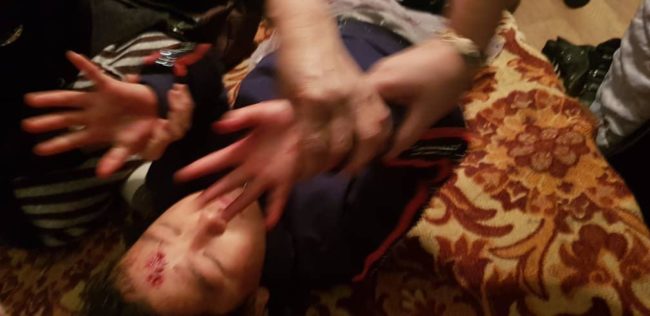
Witness statements about the purposeful planning of the pogrom require careful review and an impartial investigation. If it is true that pogromists from other regions were mobilized using online apps, that special bottles containing a flammable mixture were prepared, and that vehicles were re-outfitted for attacks and pogroms, then this could not have been overlooked by law enforcement authorities, and the question of their inaction, which had such tragic consequences, should be examined.
Attempts to attain justice: Who can Kazakhstan’s ethnic minorities rely on?
On May 8, the Dungans from the villages that suffered in the pogrom published an open letter to the authorities of Kazakhstan, the media, and international organizations describing the facts of arbitrary detentions and torture. They wrote: “After the tragedy that we went through, our children still cannot sleep at night, even adults are frightened and do not want to go outside and risk being detained. The victims cannot get any subsidies or compensation for the damages inflicted. We call upon Kazakh society to protect us, because we are the same citizens as you are! We are tired of fear! We want peace!”
his appeal was a gesture of despair on the part on Dungans, who have tired from the arbitrary treatment of the authorities and the persistent harassment they have been forced to endure over the past three months. One would think that the Kazakh government should provide comprehensive assistance to the Dungan community after this tragedy, but decisions on humanitarian issues, psychological support for the victims, and, in some cases, medical care, are being made through the efforts of the Dungan community itself.
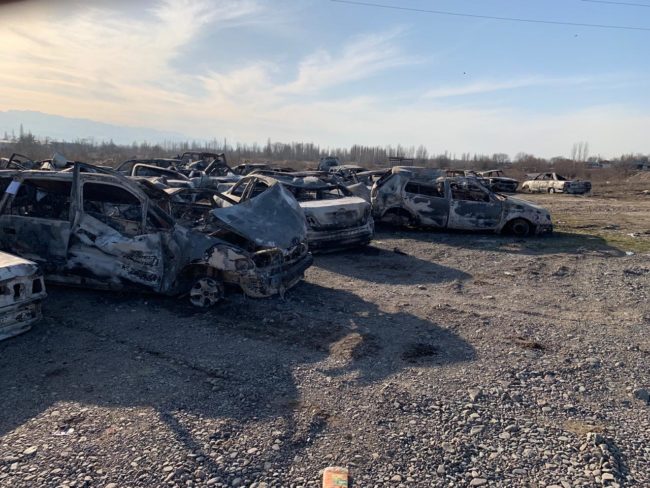
Dungans living in Kazakhstan are afraid and, in the face of a pandemic, do not have the opportunity to protect their rights. Dungans from Kyrgyzstan are standing in solidarity with them. For example, in an appeal of May 14, they called on international organizations:
1) to appeal to the government of the Republic of Kazakhstan to stop the persecution of the Dungan community, prosecute leaders who allowed for violations of fundamental human rights and torture. Ensure an impartial investigation of the events of February 7 and 8 in Korday District and prosecute the organizers of the mass unrest that resulted in deaths. Compensate the victims and business owners for damages caused by the unrest.
Dungan’s appeal to UN Human Rights Treaty Bodies and Special Procedures
2) Help representatives of UN treaty bodies and other international organizations visit the scene of the tragedy to collect direct evidence and information about the events. Since the time these events occurred, not one international organization, including organizations located within the country, with the exception of humanitarian organizations, have been able to visit the scene of the events, since their requests have been denied by Kazakh officials.
Alarming signals that were ignored
The events of February 7 and 8 were the most brutal, but far from the first, instances of ethnic discord in recent years. In recent times, Kazakhstan has seen repeated ethnic conflicts provoked for different reasons, from banal mundane disputes to deeper problems connected, on the one hand, with the lack of integration of ethnic minorities, and, on the other hand, with the increasing popularity of the ideas of nationalist-patriots. For example, in 2007 a mass fight between Kazakhs and Chechens in Almaty Oblast resulted in nine deaths and pogroms of Chechen stores and homes, whose owners had no relationship to the conflict. Also in 2007, unconfirmed rumors about the rape of a Kazakh child spilled over into arson and attacks on Kurds in the village of Mayatas that lasted for three days. As a result, 90 percent of residents were forced to flee their homes. In 2015, the murder of a Kazakh official provoked a pogrom of dozens of homes and cars belonging to Tajiks in Saryagash District, South Kazakhstan Oblast. Finally, in 2018, a fight between young people of different nationalities in an Armenian restaurant led to anti-Armenian actions and meetings in Karaganda, after which several Armenian families fled the city in fear of reprisals.
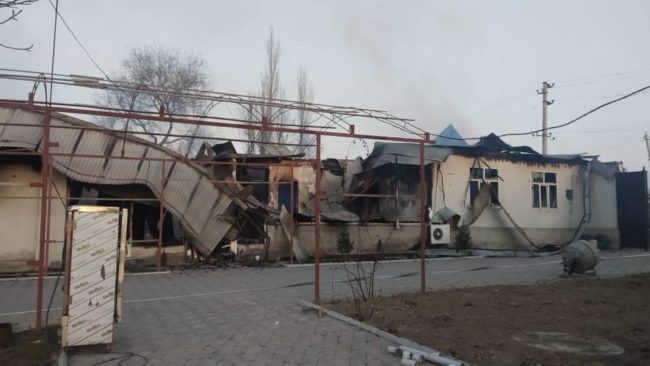
A serious discussion about ethnic relations in Kazakhstan is required
Even though the conflict in Korday District was markedly ethnic in nature and clearly planned in advance, the Kazakh authorities have not recognized the ethnic or racial motives of the attackers and concealed the consequences of the pogroms for several days. The event was called a “mass brawl” or “a squabble between criminals,” with Dungans being portrayed as instigators of the violence instead of victims. Meanwhile, human rights defenders and activists started to report that state agencies were interfering with the media’s work and asking the media to only publish the official position. The authorities also did not let international or Kazakh human rights organizations into the area and put pressure on Dungans who suffered in the pogroms and their attorneys.
The xenophobic attacks and calls to violence that sounded during the pogroms and continued to appear in the media in Kazakhstan were not roundly condemned by the authorities. In fact, the words of Kazakh village elders and the posts of well-known bloggers, which were both laced with chauvinism and hatred in relation to Dungans, were approved in earnest, which can be seen from the numerous favorable comments made by their audiences. Ethnic tension in Kazakhstan is evidenced by the inadequate, violent reaction to a special statement to the Prosecutor General of Kazakhstan published by the Coalition of NGOs of Kazakhstan Against Torture reacting to the illegal actions of law enforcement officers in the villages of Korday District 8Coalition of NGOs Against Torture, Statement Regarding Police Raids in the Affected Villages of the Korday District https://www.notorture.kz/obrashhenie–v–svyazi–s–policzejskimi–rejdami–v–postradavshie–sela–kordajskogo–rajona/?fbclid=IwAR0UGWBfVksdxHZzpvBsdPB8WUWFbud3xNSJ4CJsBMV57L_t5ANd0kW–iUc [in Russian] . After the publication of the statement, the lawyer of Kazakhstan International Bureau for Human Rights and Rule of Law listed as a contact in the statement received phone calls with threats from unknown persons who perceived the statement as support of the accused based on ethnicity 9Coalition Against Torture, Statement Regarding Threats Against the Coordinators of the Coalition of NGOs Against Torture, https://www.notorture.kz/zajavlenie–po–povodu–ugroz/ [in Russian]. Aggressive nationalistic threats related to the statement of the Coalition in support of the Dungans also became a part of the smear campaign against Yevgeniy Zhovtis, head of the Kazakhstan International Bureau for Human Rights and Rule of Law, that appeared in the media and online10https://www.frontlinedefenders.org/ru/case/smear-campaign-against-human-rights-defender-evgeniy-zhovtis
It has become clear to many Kazakh analysts that flare-ups of terrible violence have led to a strategy of denying the problem of ethnic tension in Kazakh society, which has existed for many years. Under Nursultan Nazarbayev, who positioned himself as the main guarantor of the peaceful co-existence of different ethnicities, there was no public debate about these problems, which was instead replaced with a pretty picture captioned “ethnic concord is our chief value.” Now many acknowledge that the country’s entire system of national policy is in deep crisis and that, as the events in Korday showed, Kazakh society is not ready to acknowledge equality between ethnicities and instead prefers the paradigm of “us versus them.” If the current government continues to pander to nationalists and deny or remain silent about ethnic discrimination and ethnic problems, linguistic and cultural diversity and peace and harmony in the country will remain under threat.









 Feedback
Feedback 